
Anne Margrethe
Brigham (2000) 'Land Reform: A Foundation For Industrial
Growth In Developing Countries?'
Sociological
Research Online, vol. 5, no. 3,
<http://www.socresonline.org.uk/5/3/brigham.html>
To cite articles published in Sociological Research Online, please reference the above information and include paragraph numbers if necessary
Received: 21/8/2000 Accepted: 23/11/2000 Published: 31/11/2000
 Abstract
Abstract Introduction
Introduction
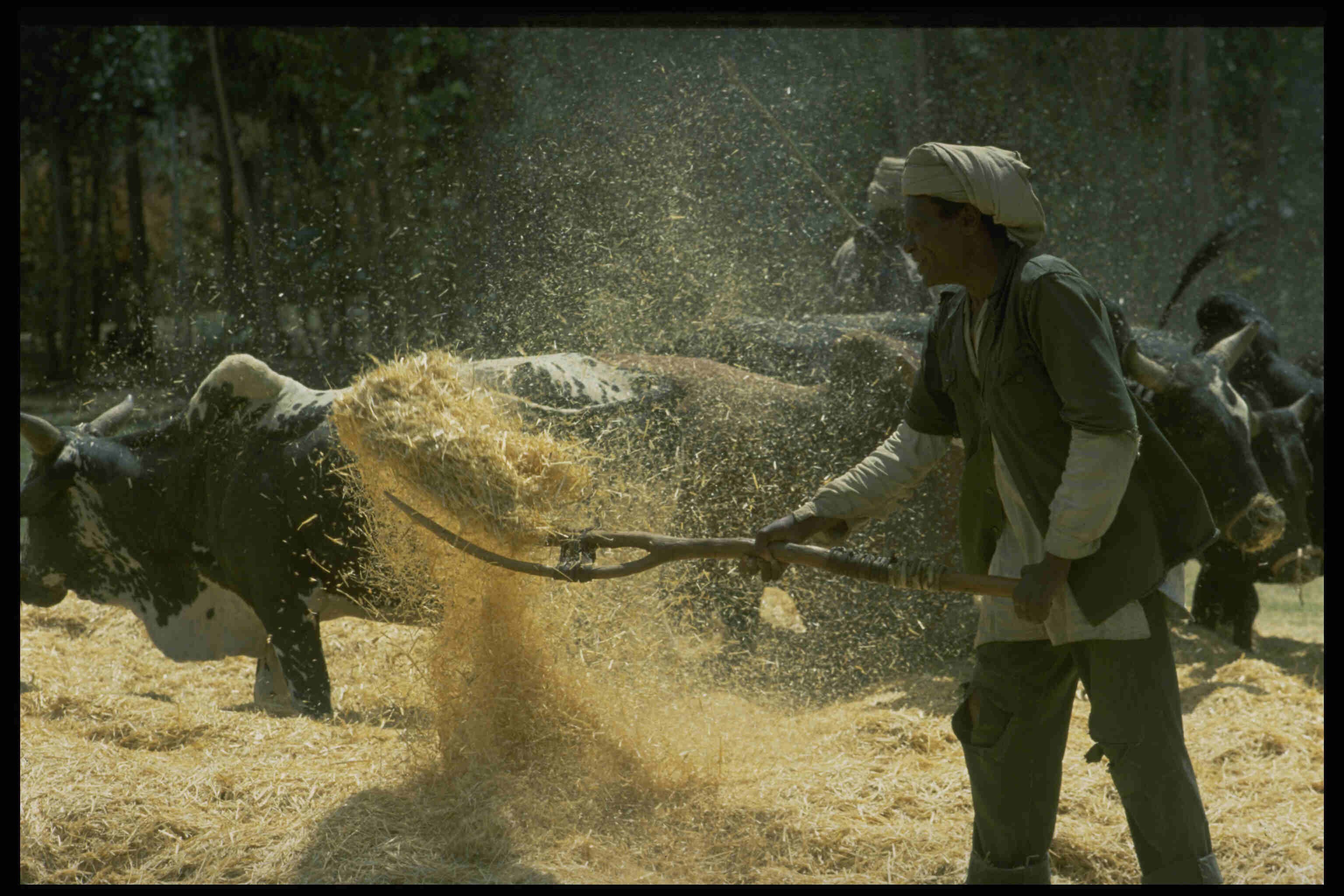
 Land Reform and Agricultural Production
Land Reform and Agricultural Production
Figure 1: Agricultural production trends in selected countries where the operational size has been reduced (Indices, 1979-1981=100)
a) Phillippines
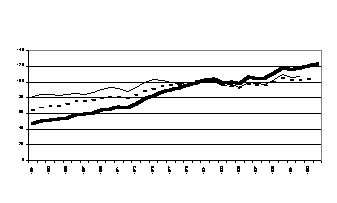
b) Zimbabwe
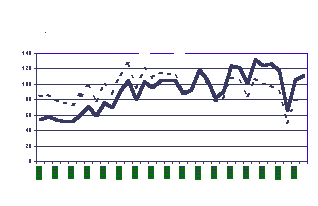
c) Chile
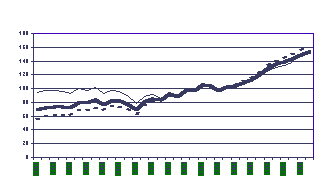
Figure 2: Agricultural production trends in selected countries where estates were turned into
cooperatives (Indices, 1979-81)
a) Nicaragua
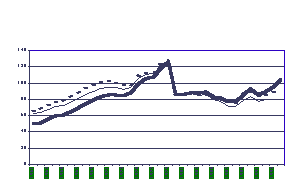
b) El Salvador
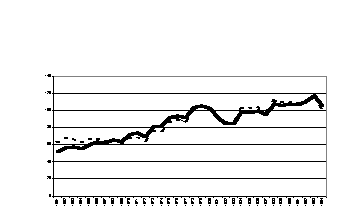
c) The Dominican Republic
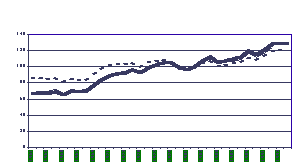
d) Peru
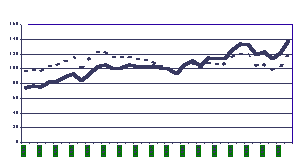

Source: FAO (1995)
Note: Where the "per 1000 ha." trend line is not visible, it lies under the total trend line.[6]
 Land Reform and "On Farm Consumption"
Land Reform and "On Farm Consumption"
Table 1: Surplus of grain available for rural areas in China, 1954/55-1956/57. (Millions of tons)
| 1954/55 | 1955/56 | 1956/57 | ||
| Total grain output | 169,5 | 183,9 | 192,7 | |
| Total collections and purchases | 53,9 | 52,0 | 49,9 | |
| Re-sales to rural areas | 24,7 | 20,2 | 24,5 | |
| Available for urban consumption, exports and government stockpiles | 29,2 | 31,8 | 25,2 | |
Source: Eckstein,1966:312
 Conclusion
Conclusion
 Notes
Notes2The sample in my analysis is constrained by the availability of time series data. Data on aggregate agricultural production that are comparable over time is only available from 1961. This is why important reforms such as the ones implemented in Mexico, Bolivia, Taiwan, Japan, South Korea, and Kenya are left out of the analysis (as well as the Ethiopian case where there is almost a total lack of data).
3A typology of reforms into these two distinct groups is somewhat problematic, because most reforms are a mix of the two, and because the nature of the reforms often change over time. I have classified the countries according to the most common ownership structure in the reformed sector in the first decade after the reform. The sources for my classification are Bruce (1998) for Zimbabwe, El-Salvador, Peru, and Chile, Adams (1995) for the Philippines, Dorner (1992: 40- 41) and Stanfield (1989: 334) for the Dominican Republic, and Thiesenhusen (1995: 87-114 and 128-129) for Chile and Nicaragua.
4To be defined as a land reform, the ownership to a substantial part of the agricultural land in a country must have been redistributed in either of these two ways as a result of political intervention (as opposed to by the "invisible hand" or by manipulation of taxes or factor prices. The source as to whether reforms have been substantial is Thiesenhusen (1989: 10), Adams (1995) and Bruce (1998: 41). The year of implementation of the reforms refers to the year where the reform law was passed. For the analytical purpose of studying the effects of the reforms, it may, artificial to use this year as break-off point, as the implementation of the reforms may stretch out in time. We will keep this in mind when studying the trends.
5In order to control for these variables I will need to compare the productivity trends from the part of the country's agricultural land that has been "reformed", with the trends in the rest of the agricultural sector. I am now in the process of collecting such data, and the results of my analysis will be presented in my PhD thesis on the effect of land reform on food security in developing countries.
6Source: FAO 1995 (Time series data for "The State of Food and Agriculture". 1995. FAO, Rome)
7The reform process started earlier, but did not redistribute enough land to be considered significant until 1967.
8The question of optimum farm size is an important issue, not only in relation to weather, but also with regard to the type of farming (extensive vs. intensive, dry land vs. irrigation, etc) as well as input and market price fluctuations.
9For simplicity, I will refer to these two types of consumption combined when I use the terms "on farm consumption" and "consumption of agricultural products in the agricultural sector".
10The urban sector does not necessarily coincide with the industrial sector, because there may be industrial activity in rural areas too. The example may non the less be illuminating to the discussion.
 Acknowledgements
Acknowledgements
ALEXANDRATOS, N. 1995. "World Agriculture: Towards 2010". FAO, Rome.
BARRACLOUGH, S. 1991. "An End to Hunger?", Zed Books Ltd, London.
BARRACLOUGH, S. 1973. "Agrarian Structure in Latin America", Lexington Books, Lexington.
BHADURI, Ahmit. 1993. "Alternative Development Strategies and the Rural Sector", in Economic Crisis and Third World Agriculture, edited by A. Singh and H. Tabatai, pp149-178. Cambridge University Press, Cambridge.
BHARADWAJ, Krishna. 1974. "Production Conditions in Indian Agriculture. A Study Based on Farm Management Surveys", University of Cambridge, Department of Applied Economics, Occasional Paper 33, Cambridge University.
BRUCE, J. 1998. "Learning from the Comparative Experience of Agrarian Reform" Paper presented at The International Conference on Land Tenure in the Developing World, with a Focus on Southern Africa, University of Cape Town, January 1998.
DORNER, Peter. 1992. "Latin American Land Reforms in Theory and Practice: a Retrospective Analysis", University of Wisconsin Press, Madison.
DYER, Graham. 1991. "Farm Size- Farm Productivity Re-examined: Evidence from Rural Egypt", in The journal of Peasant Studies, Vol. 19, No. 1, pp. 59-92, Frank Cass, London.
EL-GHONEMY, M. Riad. 1990. "The Political Economy of Rural Poverty," Routledge, London.
ELLIS, Frank. 1988. "Peasant Economics. Farm Households and Agrarian Development", Cambridge University Press, Cambridge.
FAO. 1995. "SOFA 95". Time-series data for The State of Food and Agriculture. FAO, Rome.
FEI, John C. H. and RANIS, G. 1964. "Development of the Labor Surplus Economy". Richard D. Irwin, Homewood, Illinois.
FEI, J. C. H. and RANIS, G. 1966. "Agrarianism, Dualism and Economic Development, in: Adelman, Irma and Eric Thorbecke (eds), The Theory and Design of Economic Development, John Hopkins Press, Baltimore.
GRIMM, Josef. 1998. "Opportunities for Formal and Informal Tenure Systems for Farm Workers", Paper presented at The International Conference on Land Tenure in the Developing World, with a Focus on Southern Africa, University of Cape Town, January 1998.
JAZAIRY, Idriss, Mohiuddin Alamgis and Theresa Paniccio. 1992. " The State of Rural Poverty" The International Fund for Agricultural Development, New York University Press, New York.
KALDOR, Nicholas. 1989. "Equilibrium Theory and Growth Theory", in F. Targetti and A. P. Thirwall (eds): The Essential Kaldor, Duckworth, London, pp. 411-33.
LEWIS, W. Arthur. 1954. "Economic Development with Unlimited Supply of Labour", in The Manchester School, Vol. 22, No. 2, pp. 139-91.
LEWIS, W. Arthur. 1958. "Unlimited Labour: Further Notes", The Manchester School, vol. 26, no.1, pp. 1-32. Manchester.
LIPPIT, Victor D. 1978. " Economic Development in Meiji Japan and Contemporary China: a Comparative Study", in Cambridge Journal of Economics, Vol. 2, pp. 55-81, Academic Press Inc, London.
OSMANI, S. R. 1993. "Growth and Entitlements: The Analytics of the Green Revolution". UNU/WIDER, Helsinki.
SEN, Amartya. 1981. "Poverty and Famines. An Essay on Entitlement and Deprivation". Oxford University Press, Oxford.
STANFIELD, D. 1989. "Agrarian Reform In the Dominican Republic", in Thiesenhusen, W. Ed. Searching for Agrarian Reform in Latin America: the Dominican Case, Praeger, New York.
SKARSTEIN, Rune. 1997. "Development Theory. A Guide to Some Unpopular Perspectives". Oxford University Press, Oxford.
THIESENHUSEN, W. 1995. "Broken Promises", Westwiew Press Inc, Boulder.
THIESENHUSEN, W. Ed. 1995. Searching for Reform in Latin America, Praeger, New York.
TYLER, G. J, El-GHONEMY, R and COUVREUR, Y 1993. "Alleviating Rural Poverty Through Agricultural Growth", The Journal of Development Studies, Vo. 29, No.2, January, pp. 358-364, Frank Cass, London.
WORLD Bank. 1997. "African Development Indicators". World Bank, Washington DC.